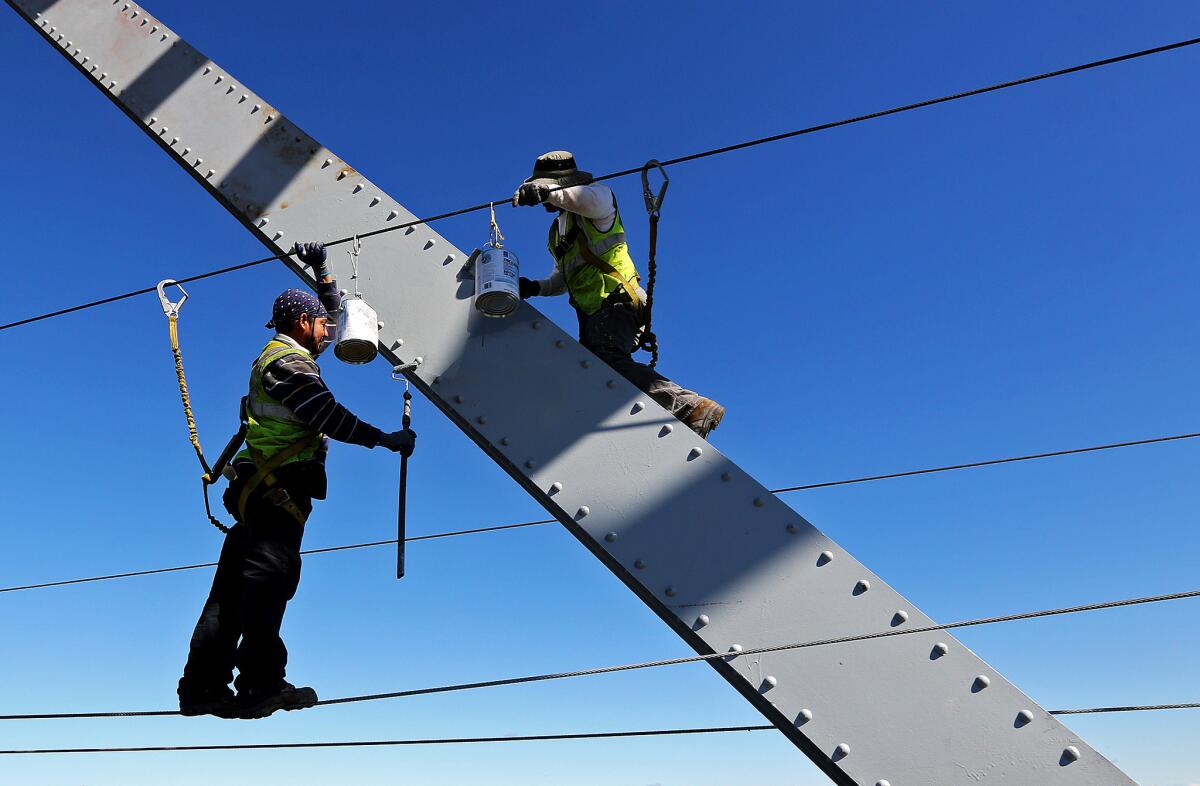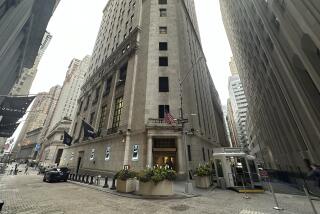August jobs report sends mixed signals to Fed on interest rate hike

Workers paint the Julien Dubuque Bridge along U.S. 20 in Dubuque, Iowa, on Aug. 24.
Reporting from Washington — Anyone looking for a sign that Federal Reserve policymakers might raise a key interest rate later this month didn’t get much of a hint from Friday’s mixed report on the labor market.
Employers added a modest 173,000 net new jobs in August, the Labor Department said Friday. That was the worst job growth since March. Coming amid global financial market turmoil in recent weeks, the figure could give policymakers pause in making a decision when they meet Sept. 16-17.
However, wages rose last month and the unemployment rate fell to 5.1%, its lowest level in seven years. And initial August job figures have been revised up significantly every year since mid-2009. Those data points described a solid labor market that could handle a small interest rate increase.
The dueling views made the likelihood of a Fed rate hike this month a toss-up.
“I don’t think it flashes either a green light or a red light for the Federal Reserve,” said Mark Hamrick, Washington bureau chief of financial information website Bankrate.com. “I think that light is still on caution.”
Even so, the volatile stock market recoiled at first and came back partially to end the trading day with losses of up to 1.7%. Traders mainly worried that the jobs report was strong enough to keep a Fed rate hike on the table.
“The market is afraid that Fed officials might interpret too much strength going forward from what is basically an average assessment of labor market conditions,” said John Lonski, chief economist at Moody’s Capital Markets Research Group.
The Dow Jones industrial average fell 1.7% to 16,102.38. The broader Standard & Poor’s 500 index dropped 1.5% to 1,921.22. The tech-oriented Nasdaq composite index slipped 1.1% to 4,683.92.
The stock declines were a fresh reminder of the recent financial market turmoil that could make central bank officials wary of raising the federal funds rate, said Nariman Behravesh, chief economist at IHS Global Insight.
“If the Fed were just looking at the economic numbers ... it would probably raise rates in a couple weeks,” he said. But “the Fed is very worried about the sell-off and the volatility in financial markets.”
That’s also true of the havoc in markets and economies worldwide. Globally, stocks plummeted in the last half of August, mainly on fears of a slower-growing Chinese economy and clumsy moves by its leaders to manage the country’s currency and markets. As China’s markets tanked, they took the world’s indexes with them.
Friday’s report of moderate job growth was well below analysts’ expectations for the creation of 223,000 jobs and down sharply from July’s 245,000 job gains.
Lower oil prices continued to take a toll on the mining industry, which shed 9,000 net jobs last month, the report said. Employment in that sector is down by 90,000 positions since December.
Meanwhile, manufacturers shed 17,000 jobs in August because of lower demand caused by the strong dollar and economic troubles in key export markets.
Offsetting those declines was strong hiring by healthcare providers, which added 41,000 net new jobs. And governments increased their payrolls by 33,000, much of that from local education hires as the new school year begins.
Looking deeper into the report, the numbers weren’t so bad. Overall job growth for June and July, for instance, was revised up by a total of 44,000 net new jobs.
And initial estimates of August job growth have been unreliable in recent years because of difficulties with complex seasonal adjustments.
Since the Great Recession ended in June 2009, job growth for every August has been revised up an average of 74,000 positions from the first estimate.
“We know that August payroll number are notoriously sketchy,” said Bankrate’s Hamrick.
Even with August’s questionable job-growth figure, the economy has added an average of 221,000 jobs over the last three months.
The unemployment rate ticked down 0.2 percentage points in August to 5.1%, the lowest since April 2008.
The rate now is nearly half what it was at its peak during the recession, reaching near what economists consider full employment.
Part of the reason for last month’s decline was that about 41,000 people dropped out of the labor force. The percentage of adults participating in the labor force remained steady at 62.6%, the lowest level since 1977.
But economists increasingly believe that the low participation rate is related more to demographic issues, particularly the retirement of baby boomers, than weakness in the labor market.
In another positive sign, wage growth accelerated last month.
Average hourly earnings jumped 8 cents to $25.09, the largest gain since January. That followed a solid 6-cent increase in July.
For the year ended Aug. 31, average hourly earnings are up 2.2%, which was well above the low inflation rate.
As the jobs picture has improved, many analysts had expected the Fed would raise its benchmark federal funds rate by 0.25 percentage points at its September meeting. The rate has been near zero since late 2008 to try to stimulate economic growth.
About 65% of economists polled in early August by financial information website Bankrate.com said the Fed could start raising the rate as early this month.
But that was before China devalued its currency, triggering sell-offs in global stock markets.
When Bankrate.com surveyed economists again this week, just 42% said a rate hike would come in September.
Unless financial markets settle down before the next Fed meeting, Behravesh said he now expected central bank policymakers to hold off on a rate hike until later this year.
“I don’t think they’re worried that a quarter-point hike will hurt the economy. It won’t,” he said. “I think they’re worried that raising rates now will add more volatility to the market.”
Shortly before the jobs report was released, a top Fed policymaker said Friday that financial market volatility should not delay a rate hike.
Jeffrey Lacker, president of the Federal Reserve Bank of Richmond, Va., said in a speech to a local retail merchants group that “the Fed has a history of overreacting to financial market movements that seem unconnected to economic fundamentals.”
Lacker, a voting member of the policymaking Federal Open Market Committee, noted that the unemployment rate “has fallen more rapidly than many people expected” from its Great Recession peak of 10% in October 2009.
And with the “slow but steady” economic growth and with inflation showing signs of picking up, it’s time for the Fed to start raising its benchmark interest rate, he said.
“I am not arguing that the economy is perfect, but nor is it on the ropes, requiring zero interest rates to get it back into the ring,” Lacker said. “It’s time to align our monetary policy with the significant progress we have made.”
Sophia Koropeckyj, senior economist at Moody’s Analytics, said the likelihood that August’s job growth figures would be upwardly revised means she expected the Fed to raise the interest rate this month.
“If the Fed does move [to raise the rate], I think it could have a good impact on the markets because it would mean there is enough confidence in the economy that it can weather various types of head winds,” Koropeckyj said.
“I’m not ready to say it’s going to calm the markets, but it would show some confidence in the strength of the economy — the real economy — not what’s going on in the markets,” she said.
More to Read
Inside the business of entertainment
The Wide Shot brings you news, analysis and insights on everything from streaming wars to production — and what it all means for the future.
You may occasionally receive promotional content from the Los Angeles Times.











